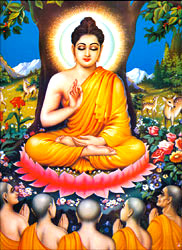 Sangha actually means Buddhist Priests of high degree of realization or the Arya Sangha or `noble Sangha` or assembly of seekers seeking what is actual and true. The Buddhists traditionally believe that monastic life provides a way towards enlightenment and the Sangha is dependable for maintaining, transforming and spreading the teachings of the Buddha. The four ways of Sangha are, practicing the good way, the upright way, the knowledgeable or logical way and lastly practicing the proper way of living. This Sangha of the Blessed One`s disciples are worthy of gifts, worthy of hospitality, worthy of offerings, worthy of reverential salutation and the unsurpassed field of merit for the world.
Sangha actually means Buddhist Priests of high degree of realization or the Arya Sangha or `noble Sangha` or assembly of seekers seeking what is actual and true. The Buddhists traditionally believe that monastic life provides a way towards enlightenment and the Sangha is dependable for maintaining, transforming and spreading the teachings of the Buddha. The four ways of Sangha are, practicing the good way, the upright way, the knowledgeable or logical way and lastly practicing the proper way of living. This Sangha of the Blessed One`s disciples are worthy of gifts, worthy of hospitality, worthy of offerings, worthy of reverential salutation and the unsurpassed field of merit for the world.
Formation of Sangha
Gautam Buddha is symbolised by the sacred icon and the Dharma by the handwritten or printed volumes of the Scriptures and the Arya Sangha is represented, for practical purposes, by the Bhikshu-Sangha or Order of Monks. This great institution is the oldest surviving religious order in the world. It came into existence within a few months of the Buddha`s great Enlightenment. It consisted of those of the Buddha`s followers who, having renounced the household life, devoted the whole of their time and all their energies to the realization of Nirvana.
Various Stages of development of Sangha
Sangha passed through various stages of development. At first, during the early lifetime of the Founder, the Sakyapatra Sramanas they remained outwardly indistinguishable from the other religious fraternities of the time. They professed a special Dharma. They assembled twice a month on the days of the full moon and new moon, were of fixed residence during the rains, and so on. The second period of development may have started before the Parinirvana. Finally, the Sangha was split up into a number of virtually autonomous local communities, and the Pratimoksha had to be supplemented by the Skandhakas. All these developments occurred within the space of about two centuries. Pratimoksha and Skandhakas together constitute the Vinaya, a term originally connoting simply the practical or disciplinary aspect of the Dharma.
Parallel with the Bhikshu-Sangha a `Bhikshuni-Sangha` or Order of Nuns was also developed. The `Bhikshuni-Sangha` plays an insignificant part. In a more general sense the Sangha comprises the entire Buddhist community, sanctified and unsanctified, the professed religious and the lay devotees, men and women. As such it is sometimes known as the Maha Sangha or `Great Assembly`. Lay devotees are those who go for refuge to the Three Jewels, worship the relics of the Buddha, observe the Five Precepts of ethical behaviour and support the monks.
After being consolidated into distinct versions of the Dharma, the regional traditions eventually emerged as independent sects. Tensions arose between the monks of the east and the monks of the west; and the Mahasanghikas, who were more sympathetic to the spiritual needs of the laity, splintered from the Sthaviravadins. They tended to interpret the Dharma in exclusively monastic terms. This was the first formal schism within the Sangha.
Features of Sangha
In Buddhist monasticism or Shangha the most important feature is the devotion to the Vinaya which contains an elaborate set of rules of conduct including absolute chastity and that one had to eat only before noon time. The rest part of day is spend performing a strict life of scripture study, chanting mantras, meditating, and occasional cleaning forms most of the Sangha`s duties. Transgression of rules carries penalties ranging from confession to permanent expulsion from the Sangha. According to Buddhism, monks and nuns possesses minimum assets, these are three robes, an alms bowl, a cloth belt, a needle and thread, a razor for shaving the head, and a water filter.
By tradition Buddhist monks and nuns avoid ordinary clothes and wear robes. Mainly the robes are sewn together from rags and stained with earth. The robes were dyed with saffron. Bhikshu is the word which is a synonym of monk. The female form is Bhikshuni. Bhikshu or Bhikshuni are the words that means `beggar`, and it is traditional for Bhikshus to beg their food. In many places this has become a complicated ritual, where people feed monastic in order to obtain merit which will ensure them a fortunate rebirth.
Gautam Buddha established the Sangha with the goal of preserving the teachings, strengthening discipline, and serving as an example for the laity. The Sangha teach and counsel to the ignorant at demand, while laymen and laywomen offer donations for their future support. This inter-connectedness serves as a marriage and has thus helped in spreading Buddhism.









